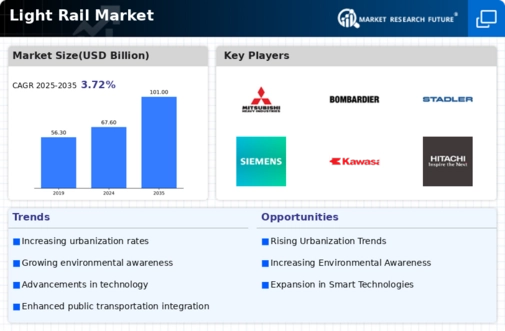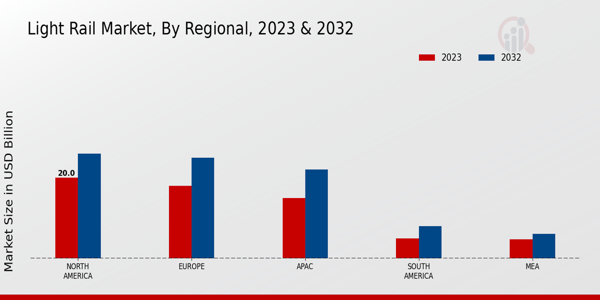Market Growth Projections
The Global Light Rail Market Industry is poised for substantial growth, with projections indicating a market value of 67.6 USD Billion in 2024 and an anticipated increase to 101.0 USD Billion by 2035. This growth trajectory suggests a compound annual growth rate of 3.72% from 2025 to 2035. Such figures reflect the increasing recognition of light rail as a viable transportation solution in urban settings. The expansion of light rail networks across various regions is likely to be driven by urbanization, government support, and technological advancements, positioning the industry for a robust future.
Government Initiatives and Funding
Government initiatives aimed at enhancing public transportation infrastructure are pivotal for the Global Light Rail Market Industry. Various countries are investing heavily in light rail systems as part of their urban development strategies. For example, the United States has seen increased federal funding for light rail projects, which encourages local governments to pursue such initiatives. This financial support is crucial, as it not only facilitates the construction of new systems but also the expansion of existing ones. The market is expected to reach 101.0 USD Billion by 2035, indicating that government backing plays a significant role in the industry's growth trajectory.
Urbanization and Population Growth
The rapid urbanization and population growth across the globe are driving the Global Light Rail Market Industry. As cities expand, the demand for efficient public transportation systems increases. For instance, urban areas are projected to house 68 percent of the world's population by 2050, necessitating sustainable transit solutions. Light rail systems offer a viable alternative to road congestion and pollution, making them attractive to city planners. This trend is reflected in the market's projected growth, with an estimated value of 67.6 USD Billion in 2024, highlighting the urgency for cities to adopt light rail solutions to accommodate growing populations.
Environmental Sustainability Concerns
Growing concerns regarding environmental sustainability are influencing the Global Light Rail Market Industry. Light rail systems are recognized for their lower carbon emissions compared to traditional transportation methods, aligning with global efforts to combat climate change. Many cities are adopting light rail as a means to reduce their carbon footprint and promote cleaner air. For instance, cities like Paris and Los Angeles are expanding their light rail networks to meet sustainability goals. This shift towards eco-friendly transportation options is expected to contribute to a compound annual growth rate of 3.72% from 2025 to 2035, reflecting the increasing prioritization of environmental considerations in urban planning.
Technological Advancements in Rail Systems
Technological advancements in rail systems are significantly impacting the Global Light Rail Market Industry. Innovations such as automated trains, advanced signaling systems, and energy-efficient technologies are enhancing the efficiency and safety of light rail operations. For example, cities are increasingly adopting smart technologies to improve passenger experience and operational efficiency. These advancements not only attract more riders but also reduce operational costs, making light rail systems more appealing to municipalities. As technology continues to evolve, it is likely that the market will see further growth, driven by the demand for modernized and efficient transit solutions.
Public Preference for Efficient Transit Solutions
Public preference for efficient and reliable transit solutions is a key driver of the Global Light Rail Market Industry. As urban populations grow, commuters are increasingly seeking alternatives to personal vehicles that offer convenience and speed. Light rail systems are often viewed as a solution to traffic congestion and long commute times. Surveys indicate that a significant portion of the population favors public transit options that are both efficient and environmentally friendly. This shift in public sentiment is likely to bolster the market, as cities respond to these preferences by investing in light rail infrastructure to enhance urban mobility.










